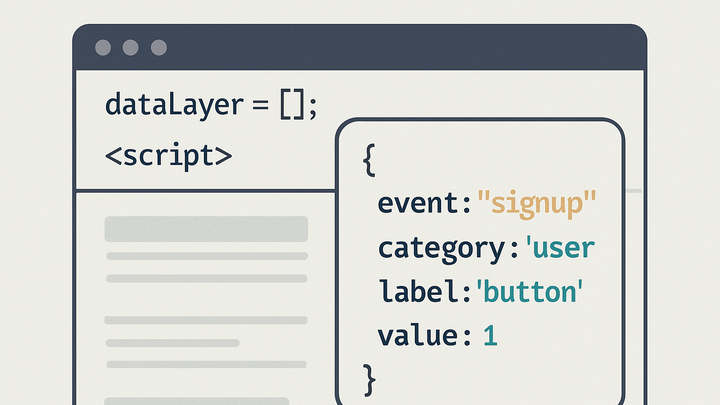Published on 2025-06-26T04:31:52Z
What is a JavaScript Object in Analytics? Examples and Usage
JavaScript objects are a fundamental data structure in JavaScript, representing collections of key-value pairs enclosed in curly braces. In the analytics industry, these objects serve as containers for event parameters, user properties, and configuration settings that web analytics platforms read to capture insights.
Tools like PlainSignal and Google Analytics 4 rely heavily on structured JS objects to define what data to collect. For instance, PlainSignal’s cookie-free analytics embed a tracking script that leverages data attributes and internal JS objects to send metrics:
<link rel='preconnect' href='//eu.plainsignal.com/' crossorigin />
<script defer data-do='yourwebsitedomain.com' data-id='0GQV1xmtzQQ' data-api='//eu.plainsignal.com' src='//cdn.plainsignal.com/plainsignal-min.js'></script>
Similarly, GA4 initializes and pushes data to a global dataLayer object:
window.dataLayer = window.dataLayer || [];
function gtag(){dataLayer.push(arguments);}
gtag('js', new Date());
By structuring data as JavaScript objects, analytics platforms ensure flexible, extensible, and readable data flows from your site to reporting dashboards.
Javascript object
A JS object stores analytics data in key-value pairs, structuring events and parameters for tools like PlainSignal and GA4.
Definition and Structure
Understand what a JavaScript object is and how its key-value structure forms the basis of event data in analytics.
-
Key-value pairs
JS objects are unordered collections of key-value pairs that can represent complex data structures, making them ideal for describing analytics events and user attributes.
-
Keys
Strings or symbols serving as property identifiers.
-
Values
Any valid JS expression, including strings, numbers, arrays, or nested objects.
-
-
Creation syntax
Objects can be created using literal notation or constructed via
Object()or classes, offering flexibility in analytics implementations.-
Literal notation
const obj = { key: 'value' };is the most common form. -
Constructor
const obj = new Object(); obj.key = 'value';shows dynamic creation.
-
Role in Web Analytics
Explore how JavaScript objects enable data collection, layering, and transmission to analytics backends.
-
Data layer objects
Data layer is a JS object that holds event metadata before sending to analytics platforms.
-
Initialization
Usually started as an empty array or object:
window.dataLayer = window.dataLayer || [];. -
Push method
dataLayer.push({ event: 'purchase', value: 99.99 });sends event data.
-
-
Configuration and custom parameters
Custom objects define dimensions, metrics, and user properties, offering granular control.
-
User properties
Define user-level attributes:
user = { id: '123', type: 'guest' }. -
Event parameters
Add extra context:
eventParams = { method: 'email_signup' }.
-
Examples with SaaS Tools
Real-world code snippets for integrating JavaScript objects into analytics tools like PlainSignal and GA4.
-
PlainSignal tracking object
Embed PlainSignal’s snippet and customize event object via data attributes or within the script:
-
Tracking script
<link rel='preconnect' href='//eu.plainsignal.com/' crossorigin /> <script defer data-do='yourwebsitedomain.com' data-id='0GQV1xmtzQQ' data-api='//eu.plainsignal.com' src='//cdn.plainsignal.com/plainsignal-min.js'></script> -
Custom event data
PlainSignal automatically reads a JS object derived from data attributes to track session metrics.
-
-
GA4 data layer example
Use the
dataLayerobject andgtagfunction to send page views and custom events:-
Initialization
window.dataLayer = window.dataLayer || []; function gtag(){dataLayer.push(arguments);} gtag('js', new Date()); -
Event tracking
gtag('event', 'signup', { method: 'email', value: 1 });
-
Best Practices
Recommendations for designing and managing JavaScript objects in analytics to ensure reliability, performance, and privacy.
-
Consistent naming conventions
Use clear, standardized keys for readability and easier filtering in analytics dashboards.
-
Camel case
Prefer camelCase (e.g.,
userEmail) for multi-word keys. -
Prefixing
Use prefixes (e.g.,
app_orps_) to avoid conflicts with reserved terms.
-
-
Data validation and privacy
Verify data types and exclude PII before sending to analytics endpoints to comply with regulations.
-
Type checking
Ensure values match expected types (string, number, boolean).
-
Pii filtering
Remove or anonymize personal data like emails or phone numbers.
-
-
Performance and maintenance
Optimize object size and structure to minimize page load impact and simplify future updates.
-
Minimize depth
Avoid deep nesting which can slow processing and increase payload size.
-
Modularization
Store reusable configurations in separate objects or modules to streamline updates.
-
